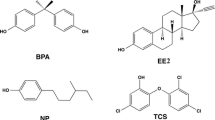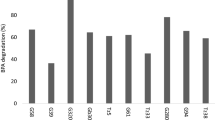Abstract
Bisphenol A (BPA) is an endocrine disruptor compound acting on animals, especially aquatics, and humans. It can leach out of urban and industrial wastes and contaminate the environment. This study evaluated comparatively the decontamination potential of three ligninolytic fungi, Trametes versicolor, Stereum hirsutum and Pleurotus ostreatus, towards BPA at a concentration of 4.6 mg L−1 in distilled water (control) and two freshwaters, a lake water and a river water. The assessment of mycelial growth during water decontamination evidenced a good tolerance of all fungi to BPA and, in some cases, a fungal growth stimulation by the organic content of the two freshwaters, with respect to the control. In the absence of fungi, BPA persistence in water appeared negatively related to the organic matter content of water, resulting in the order: distilled water > river water > lake water. All the three fungi showed a larger removal of BPA in freshwaters with respect to distilled water. T. versicolor and P. ostreatus exerted a similar relevant capacity to remove BPA from both freshwaters, whereas S. hirsutum was much more effective in the decontamination of lake water with respect to river water.
Access this chapter
Tax calculation will be finalised at checkout
Purchases are for personal use only
Similar content being viewed by others
References
Belfroid, A., M. van Velzen, B. van der Horst, and D. Vethaak. 2002. Occurrence of bisphenol A in surface water and uptake in fish: Evaluation of field measurements. Chemosphere 49: 97–103.
Cajthaml, T., Z. Křesinová, K. Svobodová, and M. Möder. 2009. Biodegradation of endocrine-disrupting compounds and suppression of estrogenic activity by ligninolytic fungi. Chemosphere 75: 745–750.
Campbell, G.C., S.E. Borglin, et al. 2006. Biologically directed environmental monitoring, fate, and trans-port of estrogenic endocrine disrupting compounds in water: A review. Chemosphere 65: 1265–1280.
Lintelmann, J., A. Katayama, N. Kurihara, L. Shore, and A. Wenzel. 2003. Endocrine disruptors in the environment. Pure and Applied Chemistry 75: 631–681.
Loffredo, E., and N. Senesi. 2006. The role of humic substances in the fate of anthropogenic organic pollutants in soil with emphasis on endocrine disruptor compounds. In Viable methods of soil and water pollution monitoring, protection and remediation, NATO sciences series, vol. 69, ed. I. Twardowska et al., 69–92. Dordrecht: Springer.
Loffredo, E., Traversa A., and Senesi N. 2012. Biodecontamination of water from bisphenol A by using ligninolytic fungi and the modulation role of humic acids. Ecotoxicology and Environmental Safety 79: 288–293.
Staples, C.A., P.B. Dorn, G.M. Klecka, S.T. O’Block, and L.R. Harris. 1998. A review of the environmental fate, effects, and exposures of bisphenol A. Chemosphere 36: 2149–2173.
Acknowledgment
This study was financed by University of Bari, Italy.
Author information
Authors and Affiliations
Corresponding author
Editor information
Editors and Affiliations
Rights and permissions
Copyright information
© 2013 Zhejiang University Press and Springer Science+Business Media Dordrecht
About this paper
Cite this paper
Castellana, G., Loffredo, E., Traversa, A., Senesi, N. (2013). The Role of Natural Organic Matter in the Biodecontamination of Freshwaters from the Endocrine Disruptor Bisphenol A. In: Xu, J., Wu, J., He, Y. (eds) Functions of Natural Organic Matter in Changing Environment. Springer, Dordrecht. https://doi.org/10.1007/978-94-007-5634-2_167
Download citation
DOI: https://doi.org/10.1007/978-94-007-5634-2_167
Published:
Publisher Name: Springer, Dordrecht
Print ISBN: 978-94-007-5633-5
Online ISBN: 978-94-007-5634-2
eBook Packages: Earth and Environmental ScienceEarth and Environmental Science (R0)




